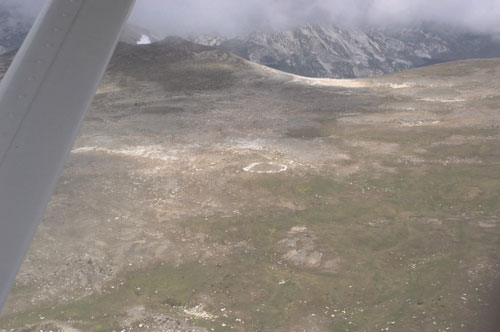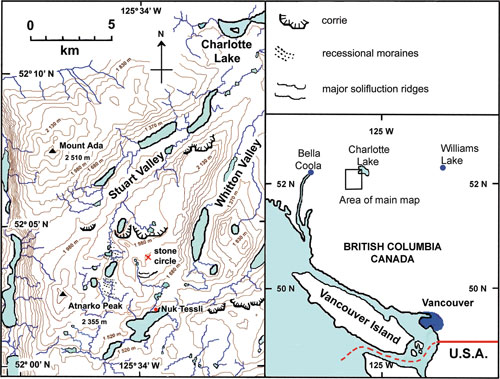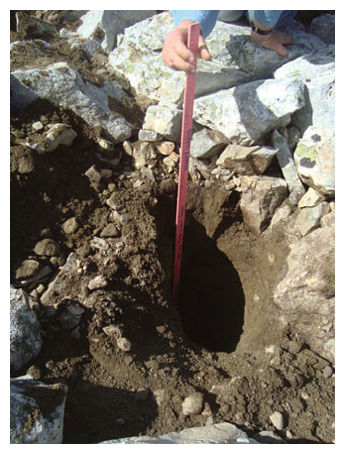Although it resembles stone circles made by humans, scientists believe that an unusual ring of stones in British Columbia is a natural feature.
© Micahel Czajkowski and Andrew Okulitch.Aerial view of the stone circle.
Scientists investigated an unusual ring of stones that was discovered in the Chilcotin Range of British Columbia and concluded that the stone circle was likely deposited by glacial activity and is not of human origin. The results of their research were
published in the December 2011 issue of the
Canadian Journal of Earth Sciences.
The ring of stones is composed of white colored felsite rocks that are high in silica. The stones are arranged in circle nearly 50 meters (164 feet) in diameter above the tree line along the Chilcotin Range in British Columbia, Canada. The white rocks stand out in stark contrast to the other darker rocks in the region, which are composed of granitoid gneiss and grandodiorite. The circle can be seen easily from the air and by viewing the terrain on Google Earth.
Many stone circles were created by humans during prehistoric times (approximately 3700 BC to 1500 BC). Archeologists believe that these circles were created either for use in religious ceremonies or as an aid in making astronomical observations. Europe contains a high number of stone circles of human origin, but examples of these structures can be found in other regions of the world as well.

© Micahel Czajkowski and Andrew Okulitch.Location of the stone circle in British Columbia.
Michael Czajkowski of The Open University in the U.K. and Andrew Okulitch of the Geological Survey of Canada examined over 400 square kilometers of the area surrounding the stone circle in British Columbia. They found a few vaguely circular features but none with the distinctive color contrast of the stone circle that they were investigating. Because of the lack of similar stone circles in the region and the low likelihood that people occupied or traveled through the region when the stone circle was formed, the scientists believe that stone circle was not created by humans.

© Micahel Czajkowski and Andrew Okulitch.Close up image of stone circle and underlying soil.
Additionally, the scientists did not find any evidence that smaller stones were stacked upon larger stones in the circle, which is thought to be a common feature of stone circles created by humans according to the scientists. Instead, they observed larger rocks overlaying smaller stones.
Czajkowski and Okulitch hypothesize that the stone circle was likely created during a period of deglaciation, when great sheets of ice were retreating from this area. As ice sheets retreat, rocks and debris are occasionally deposited in shapes known as circular moraine features. These features form when debris slides down cones of unmelted ice to form a circle on the ground. Minturn circles are another type of glacial deposit that can form when ice sheets retreat. These circular features are created by meltwater streams. While the stone circle discovered in British Columbia isn't completely similar to circular moraine features - the circle is about 3 to 5 times larger than most moraine deposits - and the scientists found no conclusive evidence that meltwater streams created minturn circles in the region, the scientists point to the occurrence of these naturally created circular glacial deposits as evidence that a glacial origin for the stone circle is a strong possibility
Comment: Natural? Yeah, right.
Do you think in 10K years they will wonder what I used it for? Currently I burn leaves in it, I think I'll throw some dog bones in the ashes to give them something more to think about. Also, maybe I will scrape some meaningless marks on a bit of wet clay and bake it hard and toss that in there too. Long wait for the payoff on a joke.